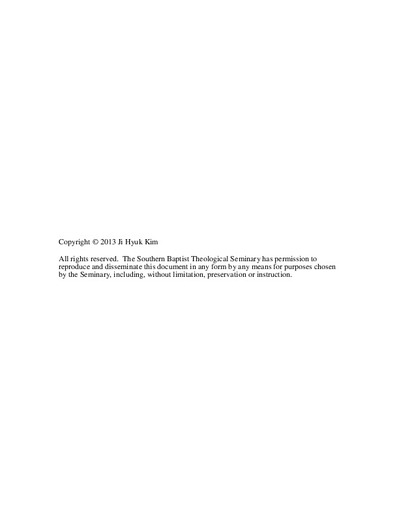| dc.contributor.advisor | York, Hershael W. | |
| dc.contributor.author | Kim, Ji Hyuk | |
| dc.date.accessioned | 2013-12-30T20:47:00Z | |
| dc.date.available | 2016-06-07T14:40:46Z | |
| dc.date.issued | 2013-12-30 | |
| dc.identifier.uri | http://hdl.handle.net/10392/4507 | |
| dc.description.abstract | The primary aim of this dissertation is to demonstrate that Jonathan Edwards's "sense of the heart" as a principle of a new kind of perception or spiritual sensation given by the Spirit of God in regeneration, in which a believer tastes or sees God's beauty, can provide expository preaching with a meaningful direction for the restoration of religious experience.
Chapter 1 focuses on the disappearance of religious experience in contemporary expository preaching and introduces, by illustrating the debate between the Old and the New Light in the First Great Awakening, an uncomfortable phenomenon in expository preaching that polarizes affectionate religious experience and cognitive-propositional truth. It argues that expository preaching should aim at affectional application because application is possible only when the listeners' fundamental affections are reoriented.
Chapter 2 examines Jonathan Edwards's spiritual epistemology by analyzing Edwards's concept of the sense of the heart, through which the saints can experience God's beauty. The sense of the heart enables the saints to obtain a new habit or the heart that brings about new affections. The chapter contends that experiencing God's beauty through the sense of the heart is central to all genuine religious experiences.
Chapter 3 defines the nature of Edwardsean religious experience as a spiritual-linguistic approach in the sense that the Spirit is the producer of genuine religious experience and the word of God illuminated by the Holy Spirit enables people to experience God's beauty and glory. It argues that expository preaching should create an experience for the listener, in Edwardsean sense, assuming that the conviction of the authority of the word of God and the encouragement of religious experience are completely compatible.
Chapter 4 presents a homiletical analysis of Edwards's affective preaching. The chapter offers a comprehensive analysis of two of Edwards's sermons, as prime examples of his rhetorical strategies, to demonstrate how vivid and dramatic images are used in his sermons. The chapter suggests that expository sermons should pay more attention to language, just as Edwards recognized that the power in the sermon lies in the masterful use of language.
Chapter 5 provides helpful implications for contemporary expository preaching. First, the chapter proposes preaching as a persuasion by illustrating Paul's use of rhetoric. Second, it indicates Edwards's power of imagination and suggests that expository preachers should pursue affective preaching by the use of their imagination and imaginative language. Third, it examines the implication of Edwardsean piety for expository preaching. Fourth, it offers preaching as a means of experiencing God's beauty.
Chapter 6 summarizes the overall arguments established in the previous chapters. The goal of our preaching should be to touch the affections of our listener's hearts to bring them beyond a merely theoretical knowledge of spiritual realities. | en_US |
| dc.subject.lcsh | Edwards, Jonathan, 1703-1758 | en_US |
| dc.subject.lcsh | Edwards, Jonathan, 1703-1758. Religious affections | en_US |
| dc.subject.lcsh | Edwards, Jonathan, 1703-1758--Sermons | en_US |
| dc.subject.lcsh | Preaching | en_US |
| dc.subject.lcsh | Experience (Religion) | en_US |
| dc.title | A Reappraisal of Religious Experience in Expository Preaching in Light of Jonathan Edwards's Sense of the Heart | en_US |
| dc.type | Electronic dissertation | en_US |
| dc.type | Text | en_US |
| dc.publisher.institution | Southern Baptist Theological Seminary | en_US |

